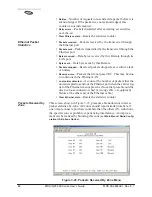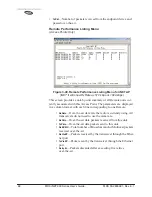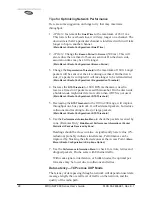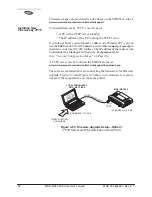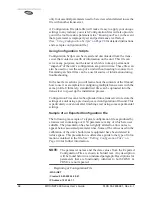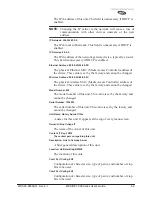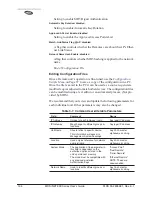
MDS 05-2806A01, Rev. E.1
MDS iNET 900 Series User’s Guide
93
•
TFTP Host Address
—IP address of the host computer from which
to get the file. [
Any valid IP address
] This same IP address is used
in other screens/functions (reprogramming, logging, etc.).
Changing it here also changes it for other screens/functions.
•
Filename
—Name of file to be received by the TFTP server.
[
Any 40-character alphanumeric string
] Verify that this corresponds
to the TFTP directory location. May require sub-directory, for
example:
\firmware\inet\inet-4_4_0.ipk
.
•
TFTP Timeout
—Time in seconds the TFTP server will wait for a
packet ACK (acknowledgment) from the transceiver before
suspending the file transfer. [
2 to 60 seconds; 10
]
•
Retrieve File
—Initiate the file transfer from the file from TFTP
server. Placed into inactive firmware position in the trans-
ceiver’s non-volatile memory [
Y, N
]
•
Image Verify
—Initiate the verification of the integrity of firmware
file held in unit.
•
Image Copy
—Initiate the copying of the active firmware into the
inactive image.
•
Reboot Device
—Initiate rebooting the transceiver. This will
interrupt data traffic through this unit, and the network if per-
formed on an Access Point. Intended to be used to toggle
between firmware images.
NOTE:
See “Upgrading the Firmware” on Page 93
for details
on setting up the TFTP server.
Upgrading the Firmware
From time-to-time MDS offers upgrades to the transceiver firmware.
One version of the firmware provides core software resources for all
transceiver models. Loading new firmware into the unit will not alter
any privileges provided by Authorization Keys and does not require the
transceiver be taken off-line until you want to operate the unit from the
newly installed firmware image.
You must use the embedded Management System for all firmware activ-
ities, including uploading from a TFTP server.
File transfers can be initiated through any of the three Management
System gateways:
•
Terminal-Emulator
—Use a terminal emulator program on your
PC, such as HyperTerminal, connected directly to the trans-
ceiver’s
COM1
port via a serial cable.
•
Telnet
—Text-based access to the Management System through
a network connection.
•
Web Browser
—Connect to the transceiver using a Web browser
on a local PC connected directly to the radio’s LAN port or
associated network.
Summary of Contents for iNET 900 Series
Page 10: ...2 MDS iNET 900 Series User s Guide MDS 05 2806A01 Rev E 1 ...
Page 26: ...18 MDS iNET 900 Series User s Guide MDS 05 2806A01 Rev E 1 ...
Page 118: ...110 MDS iNET 900 Series User s Guide MDS 05 2806A01 Rev E 1 ...
Page 120: ...112 MDS iNET 900 Series User s Guide MDS 05 2806A01 Rev E 1 ...
Page 136: ...128 MDS iNET 900 Series User s Guide MDS 05 2806A01 Rev E 1 ...
Page 148: ...140 MDS iNET 900 Series User s Guide MDS 05 2806A01 Rev E 1 ...
Page 150: ...142 MDS iNET 900 Series User s Guide MDS 05 2806A01 Rev E 1 ...
Page 164: ...156 MDS iNET 900 Series User s Guide MDS 05 2806A01 Rev E 1 ...
Page 172: ...164 MDS iNET 900 Series User s Guide MDS 05 2806A01 Rev E 1 ...




